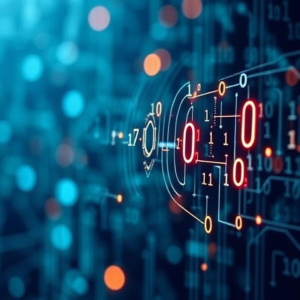Digital Communication Explained :
Digital Communication refers to the method of transmitting information using digital signals, which are made up of a series of 0’s and 1’s, also known as binary code. In simple terms, instead of sending continuous waves like in analog communication, digital communication sends data in discrete steps. In a digital communication system, information is converted into binary data (0s and 1s), transmitted over a channel, and then decoded back into its original form at the receiver’s end. Digital systems are more resistant to noise, allow for better error correction, and provide more secure and efficient communication. They are used in almost all modern communication technologies, such as the internet, cell phones, and satellite systems. Overall, digital communication is a powerful and reliable way to transmit data.

What is Digital Communication?
In a digital communication system, the information is converted into binary data (0s and 1s) before being transmitted. These 0s and 1s represent two distinct states or values, which can correspond to a variety of things (like sound, images, or text). Once transmitted, the receiver decodes the 0s and 1s back into the original form of information (like a phone call, a video, or a document).
How Digital Communication Works (Step-by-Step):
- Source Information:
- It all begins with source information, which could be anything like a sound (your voice), a picture, a text message, or a video. For example, if you’re making a phone call, your voice is the source of the information.
- Conversion to Digital Signal (Encoding):
- The source information is first converted into digital data through a process called encoding.
- For example, when you speak into a phone, your voice is first converted into electrical signals (like in analog communication). Then, these electrical signals are converted into binary numbers (0s and 1s) through a process called sampling and quantization.
- Transmission:
- The binary data (0s and 1s) is then transmitted over a communication medium, like wires, fiber optics, or even through the air (in the case of wireless communication).
- This transmission can happen through different technologies, like Wi-Fi, mobile networks, or satellite systems.
- Reception:
- On the receiving end, the digital data (0s and 1s) is received by a device, like a mobile phone or computer.
- The receiver then decodes the digital signal back into the original form of the information (like sound, text, or an image).
- Reconstruction:
- Finally, the digital data is transformed back into a usable form. If you were on a phone call, the 0s and 1s would be turned back into sound waves that you can hear.
Components of Digital Communication :
Digital communication typically involves these key components:
- Transmitter:
- This is where the original information (like your voice or a file) is converted into digital form (a sequence of 0s and 1s).
- The transmitter sends this digital data over the communication channel.
- Channel:
- This is the medium through which the data travels (e.g., phone lines, fiber-optic cables, wireless networks).
- The channel may introduce some noise, but digital signals are more resistant to this noise than analog signals.
- Receiver:
- The receiver captures the transmitted digital signal and decodes it back into the original information.
- For example, in a video call, the receiver’s device will display the video of the person you’re talking to.
Example of Digital Communication
One of the most common examples of digital communication is sending a text message:
- You type a message on your phone (this is the source information).
- Your phone converts the message into a digital signal (0s and 1s).
- The phone sends this binary data over the communication channel (the internet or mobile network).
- The message is received by the other person’s phone.
- The phone decodes the binary data and displays your message as readable text.
Advantages of Digital Communication
- Better Quality: Digital signals are less affected by noise and interference, meaning that the transmitted data remains clear and accurate.
- Efficient Data Compression: Digital systems can compress data to reduce the size of files, making it easier and faster to transmit.
- Error Detection and Correction: Digital systems can detect and correct errors more easily than analog systems. For example, if a bit gets lost or altered, the system can try to fix it.
- Security: Digital communication allows for better encryption and security, ensuring that information stays private and protected from hackers.
- Multiple Uses: Digital communication can carry voice, data, video, and more, all using the same system.
Disadvantages of Digital Communication
- Complexity: Digital communication systems tend to be more complex to design and implement than analog systems.
- Bandwidth Requirement: Digital signals sometimes require more bandwidth, meaning they may need more data transfer capacity than analog signals.
- Latency: In some cases, digital communication systems can introduce a slight delay in the transmission due to the processes of encoding, transmission, and decoding.
Applications of Digital Communication
- Cell Phones and Smartphones: Voice calls, text messages, internet browsing, and video calls all rely on digital communication.
- Internet: Websites, emails, social media, and video streaming (like Netflix) all use digital communication.
- Satellite Communication: Digital signals are sent to and from satellites for services like GPS and TV broadcasting.
- Wireless Networks: Wi-Fi and Bluetooth are examples of wireless digital communication systems.
Tags: bandwidth requirements, Binary Code, binary signals, Bluetooth communication, communication channel, Data Compression, Data transmission, Digital Communication, digital communication advantages, digital communication applications, digital communication disadvantages, digital communication system, digital communication technology, digital data, digital data reconstruction., digital encryption, Digital Modulation, digital receiver, Digital Signal Processing, digital signals, digital transmitter, discrete signal transmission, encoding and decoding, error correction, fiber optic communication, internet communication, latency in digital communication, mobile networks, Noise resistance, real-time digital communication, Satellite communication, Secure communication, smartphone communication, text message transmission, video data transmission, voice data transmission, Wi-Fi communication, wireless digital communication


